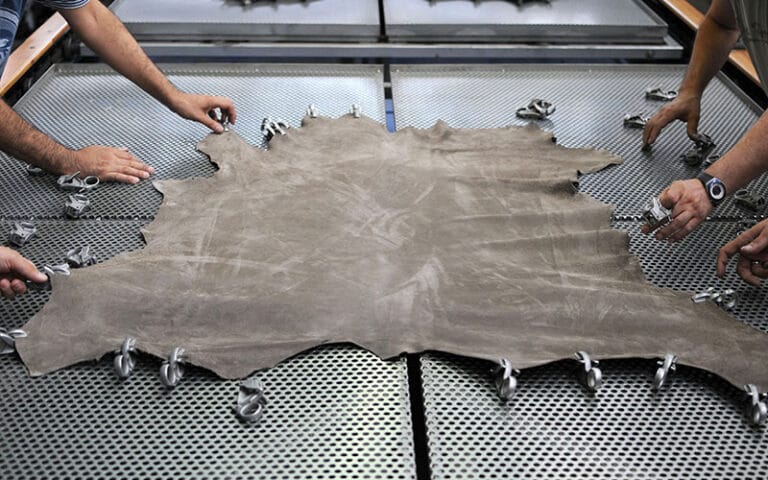Tannery production is circular by nature
The key pillars supporting leather circularity are:
Be a raw materials recovered from food industry waste
More than 99% of the raw hides used by tanneries come from cattle, sheep, and goats raised exclusively for milk and meat production.
These hides are therefore an offcut of the food industry and are classified as Animal By-Products (ABPs) under Reg. No. 1069/2009.
The tanning process recovers and enhances these ABPs, transforming them into finished leather—a valuable material with multiple applications in the market.
Leather is thus the result of one of the oldest known re/up-cycling a processes. Every year, tanneries recover approximately 1,700 square kilometers of raw hides worldwide (equivalent to 8 million tons). Without this recovery, disposing of such material would generate around 5 million tons of greenhouse gas emissions (based on UNIDO estimates).
Waste and By-Product Recovery, Water Treatment, and Chemical Reuse
The structure of the Italian tanning sector has enabled the development of a highly interconnected ecosystem where companies exchange waste, effluents, and services, significantly reducing environmental impact.
Tanning waste recovery is a prime example of circular bioeconomy in action. One of the most notable applications is the agricultural use of recovered tanning biomass, effectively closing the loop on natural materials.
In Italian tanneries, the primary processing waste is recovered and repurposed to produce:
Be a Bio-Based Material
Because of its origin, leather is inherently a bio-based material derived from renewable sources, an essential factor in reducing greenhouse gas emissions.
Unique Technical Characteristics
High durability and usability, high repairability, a significant level of biodegradability and compostability
The tanning process transforms organic waste into a stable, durable, and high-performance material with a wide range of end uses. In most cases, leather is biodegradable.
Leather embodies several principles of the European Union’s Ecodesign Regulation, which emphasizes maintaining the performance and value of materials for as long as possible to minimize waste and environmental impact.
Durability/Usability and Biodegradability/Compostability are two of the hottest topics in the global debate on the sustainability of manufacturing materials.

Durability / Usability / Repairability
Leather can age while retaining its unique characteristics , ensuring long-lasting aesthetic and functional high durability.
Additionally, leather’s resilience allows products to maintain their essential characteristics even with frequent use. In these terms, we can also speak of usability.
These features supports both reusability and repairability, further extending a product’s lifespan.
Leather goods age with their owners, developing a vintage appeal over time. This aligns with the principles of sustainable design, which emphasize emotional durability, a concept that strengthens the bond between consumers and products, reducing resource consumption and waste.
Biodegradability and Compostability
From a technical and scientific standpoint, compostability is a more precise concept than biodegradability. While biodegradability generally refers to a material’s ability to break down into CO₂ through microorganisms, compostability is more specifically regulated and measures a material’s ability to transform into compost under controlled conditions.
Biodegradability or biodegradation, is not always a positive feature of sustainability as it is important to make sure that what is produced can be made available again in the environment, without harming it, is a slow process carried out by nature, while composting is a fast process carried out by man.
When shredded and exposed to appropriate humidity and temperature conditions, leather undergoes biodegradation.
However, leather is a composite material. While its primary polymer, collagen, is biodegradable before tanning, the added substances that enhance its chemical and mechanical properties can vary the degree of biodegradability considerably.
Leather’s biodegradability can be assessed using ISO 20136.
This topic is gaining increasing attention in both supply chain relations and regulatory discussions, leading to more scientific research. Some key studies include:
Is Leather’s Biodegradability in Conflict with Its Durability?
A material’s durability is assessed by how long it can be used under normal conditions, such as temperature, humidity, and atmospheric pressure. Under these conditions, leather remains a durable material.
Monitor for Circular Fashion – SDA Bocconi
As part of broader initiatives to promote circularity in the fashion sector, UNIC and ICEC have joined the “Monitor for Circular Fashion” project. This initiative, led by the SDA Bocconi Sustainability Lab in collaboration with the European Commission (DG GROW), UNECE (United Nations Economic Commission for Europe), and major fashion brands (such as Kering, Ferragamo, Tod’s, and Vivienne Westwood), aims to:
The Monitor for Circular Fashion is a multi-stakeholder project, which aims to identify performance indicators (KPIs) of circularity in the fashion industry, highlight and disseminate good business practices in this regard, and enhance technical, managerial and scientific skills toward sustainable business models.
In the 2023 edition, UNIC and ICEC participated in the working group that developed circularity KPIs for the leather supply chain. The goal was to highlight the technical aspects of recognition, evaluation, and measurement from an eco-design perspective, focusing on product durability, material biodegradability, and production efficiency.
UNIC and ICEC also contributed to shaping sustainability claims for leather through two pilot projects:
- TOD’s Re-Gen H project, using leather from Sciarada Industria Conciaria S.p.A.
- Ferragamo’s Traced Leather Varina ballet flat project, using leather from BCN Concerie S.p.A.
In 2024, Gruppo Mastrotto S.p.A. joined the Monitor for Circular Fashion community, while UNIC and ICEC renewed their collaboration and are currently involved in two new leather-related pilot projects.




